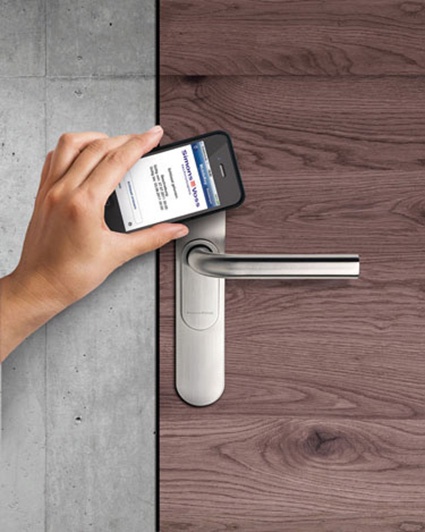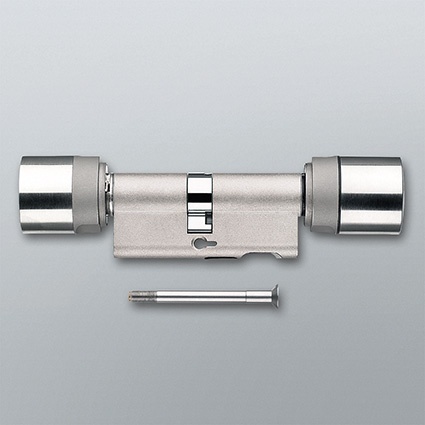Protection, Monitoring – and Smartphones Open Doors
SimonsVoss has enhanced its Electronic Locking and Access Control System 3060 with a newly designed protection function. With it, door locking devices can be activated or deactivat...


SimonsVoss has enhanced its Electronic Locking and Access Control System 3060 with a newly designed protection function. With it, door locking devices can be activated or deactivated in a split second in the event of an emergency. Users and operators of large buildings, particularly those in the public sector and the health care and education sectors, often wish for an additional protection system which can be quickly put to use in critical situations. People want to be able to act very swiftly in the event of a fire alarm or attacks on people, such as a shooting incident in a school.
This new protection function provides three responses in such emergency situations: a simple press of a button makes it impossible to open a door from the outside - intruders can no longer get inside as a result. By the same token, means of escape can also be immediately provided by pressing the button to deactivate the locking device concerned. The system also informs those in charge about the disturbance, fire, gunman attack or other emergency.
Instant Protection by Radio
SimonsVoss has provided this new protect function by extending its WaveNet Router radio network - by connecting digital locking cylinders with a central computer, for example - to offer additional functions. One single signal can reach up to 249 doors per router. Interlinked in a network, locking devices can thus be activated or deactivated simultaneously using a radio signal. Thanks to radio, the system will still work even if the communications and IT networks are already down.
Depending on the actual nature of the incident, the WaveNet Router can provide the right protection function, such as ‘Lock doors in gunman incidents' or ‘Release doors in the event of fire.' If there is a gunman in the building, doors to classrooms can be securely locked, for example. If a fire alarm is triggered, System 3060 automatically releases the right doors, opening up the way for people to escape or for help to arrive.
This function can even be retrofitted to existing systems which feature the latest TN4 Generation locking devices at a reasonable price.
Keeping an Eye on the Door: Complete Door Monitoring in Three Minutes
Is the door open or closed? Has it been locked just once or is it double-locked? Is someone trying to break in through the door? Digital Locking Cylinder 3061 can detect all these situations using SimonsVoss door monitoring and report them to a main control centre, where individual status messages for each door are displayed on the Event Agent and can be re-set when required. Probably the smallest integrated door monitoring system in the world, this door monitoring cylinder is installed within three minutes with no need to drill a single hole and without affecting door certification. Just fifteen more minutes and the complete system is ready for operation.
Three SimonsVoss technical innovations interact in this highly integrated door monitoring system: the intelligent fastening screw, the cam sensor and the monitoring logic. Designed to hold the profile cylinder securely in the lock case, the fastening screw is equipped with an intelligent system which can detect whether the door is open or closed or if an authorised person is trying to open the door at any time. The cam sensor detects the position of the dead bolt and whether it has been double-locked or just locked just once.
Digital Locking Cylinder 3061 door monitoring notifies the main control centre of the door status at all times by radio. To do so, it uses SimonsVoss WaveNet radio technology and intelligent G2 protocol functions. The Event Agent in the SimonsVoss software displays status messages and also allows you to filter or re-set messages or take action where required. If the network should crash, no damage is caused. Any information already received is not lost from the cylinder's access list.
Smartphones Now Open Doors: The NFC Access Solution MobileKey from SimonsVoss
Smartphones are the key to our world and never leave our sides. After all, wherever there is reception, we have access to the Internet. However, up until now, the clever little device wasn't smart enough to open an ordinary door with a lock and latch. That's all about to change - thanks to near field communication (NFC). This technology allows information exchange between devices at a very short distance of a few centimetres - this is the way that RFID cards, smart tags and card readers work - and now also smartphones.
The decisive trick in near field communication lies in the active display of the user's intent by means of a particular, physical act. This consists in his placing his card or NFC-compatible smartphone near to another device. For example, if he wants to open a certain door, he displays this intent by holding his card up to a card reader.
This simple display of the user's intent can now be incorporated into a wide range of applications. We differentiate between three modes:
1. Read (= Reader/Writer Mode)
The smartphone acts like a card reader. This allows people to read, for example, tags, which are small RFID chips, on so-called smart posters. These tags include web links via which people are then redirected to websites where more information on the topic is available.
2. Exchange (= Peer-to-peer Mode)
This mode involves direct, close-proximity communication between two smartphones. For example, this can be used to exchange business cards and play interactive games (social gaming) as well as create Bluetooth and WLAN connections.
3. Work As a Card (= Card Emulation Mode)
In this mode, the smartphone acts like a non-contact smartcard allowing you to use it, for example, as a credit or debit card for payment functions. Public transport ticketing can also be effected via telephone.
The card emulation, in other words the imitation of cards, is now the most interesting mode for access control in particular. Namely because the smartphone can adopt smartcard functions such as Mifare Classic and Mifare DESfire. In other words: a smartphone can open doors in this way.
Ready for the NFC Smartphone Future
The new NFC application from SimonsVoss now makes it possible to make this vision reality for a wide range of practical applications: for example, it can furnish the users' smartphone with access authorisations via mobile phone networks and allow them NFC-based access to the renowned SimonsVoss locks - in other words to digital locking cylinders, digital Smart Handles and digital Smart Relays.
A practical application example: in the past, carers and maintenance personnel had to procure the corresponding keys for their duties from a key depot and return them again afterwards. This was very time consuming and valuable working time was wasted every time.
With the new NFC-based key distribution procedure from SimonsVoss, access authorisations can now be sent directly to the employees' smartphones from the headquarters on a daily basis and, in emergencies, even for limited periods of time. At the place it is used, the mobile phone then communicates with the corresponding SimonsVoss lock components via an NFC interface. If the respective authorisations exist, the doors, gates and barriers are opened.
Access Technology Via App
From a technical perspective, it functions extremely easily from the user's point of view: the users download the SimonsVoss MobileKey app from the Apple Appstore to their iPhone (soon to be available for Android-based smartphones too). The locking systems administrator now assigns the lock authorisations to his users as usual. Whenever something changes for a user with an NFC smartphone, a new smartcard data set (Mifare Classic and in the future also Mifare DESFire) is generated automatically and pushed to a central OTA (over the air) key server.
The user can then collect his daily or hourly lock authorisations simply at the push of a key in his MobileKey app. The keys can be configured by the administrator in such a way that they only work for a specified validity period and then expire again. The corresponding doors can then be opened - when the respective authorisations exist - by simply holding the smartphone to the reader integrated in the lock.
NFC Attachment
As the card emulation, which is important for access control, was not previously supported sufficiently by smartphone manufacturers, SimonsVoss current employs so-called NFC attachments. These are iCartes for iPhone4 and iPhone4S, and microSDs for Android-based phones.
These attachments include the NFC chip for close-proximity communication and a secure element in which all security-critical information such as passwords and access authorisations are stored and cryptological calculations are performed.
The procedure demonstrated here is already working reliably for a range of test customers and is set to be launched on the market soon.
most read

Integrated and Futureproof: Traka’s Next Chapter
Interview with Stefni Oliver on Traka’s Vision for the Future


Security management, building security & perimeter protection: the winners of category E at the GIT SECURITY AWARD 2026
GIT SECURITY AWARD 2026: Security management, building security & perimeter protection - an overview of the most innovative solutions

GIT SECURITY AWARD 2026 - The winners have been announced!
GIT SECURITY AWARD 2026: The best safety and security solutions of the year - now an overview of all winners









